8 Steps to Run a Quick Social Media Audit (+ Free Template)
How long has it been since you have run a social media audit? If social media is a […] The post 8 Steps to Run a Quick Social Media Audit (+ Free Template) appeared first on SocialPilot.

How long has it been since you have run a social media audit? If social media is a crucial element of your marketing strategy (as it should be), understanding how to run an audit is imperative.
Regrettably, many businesses neglect to invest the necessary time and resources to audit their social media accounts thoroughly. The result?
They end up creating ineffective social media marketing strategies, missing opportunities, poor engagement, falling behind the competition, and wasting time and budget.
We have developed a step-by-step guide to running a successful social media audit to help you avoid operating social accounts with incomplete strategies that can hinder your business goals. We will walk you through the complete process and share a free social media audit template, checklist, tools, and examples.
What Is a Social Media Audit?
A social media audit is an in-depth analysis and review of your business’s social media presence. The process involves examining various aspects of social media accounts to understand your current performance, identify areas for improvement, and build strategies to enhance the overall impact of your social media marketing efforts.
The key metrics to track from this audit include demographics, locations, engagements, and other valuable information to drive success. The goal is to ensure your social media efforts align with business objectives and deliver the best possible results.
By doing an audit, you identify:
- Your top-performing social platforms
- Your most captivating content formats
- Initiatives that drive audience growth and potential hurdles
- New strategies you can deploy to reach your goals
How to Conduct a Social Media Audit in 8 Steps
Regardless of the nature of your or your client’s business, the audit process shared below will work for you. You’ll likely go through the ensuing steps as you embark on your first audit.
To facilitate a smooth auditing experience, download our social media audit template. Use it to document the information articulated in each step, ensuring a cohesive and comprehensive auditing process.
While our audit template has all the essential metrics, we understand that every audit may have unique objectives. That’s why we’ve included customizable sections, enabling you to integrate metrics that align with your needs.
Step 1: Define Your Goals and Establish KPIs
The first and foremost step in conducting an audit is defining your goals and KPIs. Conducting an audit without clear social media goals is akin to driving a car through a pitch-black freeway without headlights.
By setting appropriate goals for each platform, identifying and assessing relevant KPIs in your audit becomes easier. It’s crucial to remember that different social channels warrant different goals.
Whether you’re increasing your follower count, boosting conversions, or fostering a community, having well-defined goals will effectively guide the direction of your audit.
Here are some of the common goals:
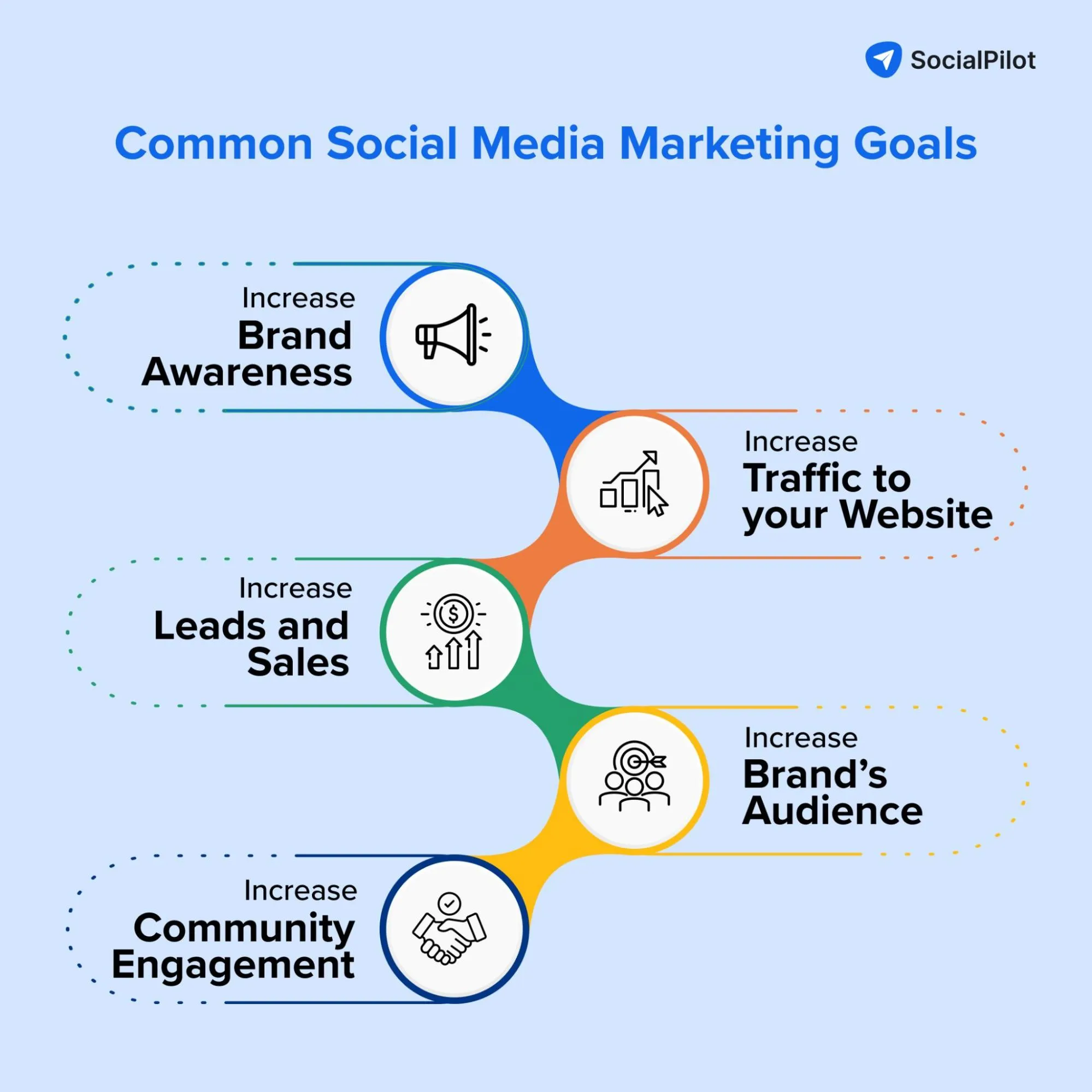
- Increasing brand awareness
- Driving website traffic
- Generating leads
- Building community
- Enhancing customer service
Ensure you set SMART goals, i.e., Specific, Measurable, Attainable, Relevant, and Time-bound goals. This framework helps you build a laser-focused strategy and increases your chances of achieving your goals.
After clearly outlining your goals, pinpointing the relevant key metrics to monitor in your audit becomes more straightforward. For instance, if one of your objectives is to increase engagement on Facebook, tracking KPIs like engagement rate, comments, likes, and shares is essential.
For instance, if one of your objectives is to increase engagement on Facebook, it’s essential to track KPIs like engagement rate, comments, likes, and shares.
Here are some of the common social metrics to include in your audit:
- Engagement metrics
- Publishing frequency
- Audience demographics
- Referral traffic
Refer to the KPIs table included in our social media audit template; input the relevant figures.

Here’s something you should also remember:
The primary objective of your inaugural audit is to examine the existing state of your social media presence and establish a benchmark for subsequent audits. Therefore, your audit must showcase the month, quarter, or year-over-year percentage change of different KPIs.
Why?
- Timely tracking will allow you to spot regular seasonal changes
- It gives you a better picture of growth with time
- Helps in making timely changes
Step 2: Make a List of Your Social Media Accounts
Once you know your goals and KPIs, begin by assembling all the social media profiles under your name in a Spreadsheet. Does this seem rudimentary? Yes. But…
You will be well aware of all your social media profiles. This crucial step ensures that no inactive profiles, created and forgotten long ago, are overlooked.
You might also uncover unofficial accounts representing your brand created by affiliates or impostors. Identifying and closing these is essential. If you struggle to access those accounts, find out if your other team members, ex-members, or your clients might have access.
The goal here is to consolidate a comprehensive list of all your social profiles in one location, enabling efficient supervision and the exploration of new or missing opportunities on any channel.
Therefore, prepare to delve into a meticulous search for your brand name on Google and every other social media network. Whether conducting an Instagram audit or taking stock of your Facebook pages, every network is important.
Step 3: Establish Benchmark
A benchmark is a standard or point of reference against which you compare your current performance. In the context of social media audit, a benchmark is a set of performance metrics that serve as a baseline to measure the effectiveness and success of your social media efforts.
Benchmarks help you understand how your current performance stacks up against your historical performance, industry standards, and competitors.
Here’s how you can establish benchmarks effectively:
- Gather your historical data – Collect your past data from social media platforms using their native analytics tools (e.g., Facebook Insights, Twitter Analytics, or Instagram Insights). To make data collection streamlined and smooth, you can use social media analytics tools like SocialPilot to gather data from all your accounts in one place and export it in a PDF.
- Understand industry standards – Research benchmarks specific to your industry to see how your performance compares to typical standards within your niche.
- Track competitors – Review the performance of your direct competitors, looking at their engagement rates, follower counts, content types, and posting frequency.
Step 4: Find out the Performance of Individual Channels
It’s time to break down the performance of each social media channel. Individually analyze the performance of each channel to determine which platforms are driving the most value for your business and which may need your attention or a revised strategy.
Some of the common metrics across social media include engagement metrics (likes, comments, shares, retweets, and overall engagement rates), reach and impressions, follower growth, CTR, and conversion rates.
To find out the performance of each channel, you can consider these questions:
- How much traffic are we driving to our website from this social media platform?
- Is the platform helping you meet your business goals?
- How do these KPIs align with our business objectives?
- How do these rates compare to industry benchmarks?
- Are there platforms where we should increase our efforts or reconsider our strategy based on performance?
Based on these metrics, analyze which platforms are the gold mine for your business. By comprehending these numbers, you can discover new opportunities.
For example, if the analysis shows a major spike in Reddit traffic, maybe you should allocate a resource and consider revising your Reddit marketing strategy.
Step 5: Assess the Best Performing Content
Breaking down your marketing efforts and identifying which channels are meeting your business goals is fundamental.
The core objective of a social media audit is to create content that brings value to your customers and returns to your investments. Hence, it’s crucial to discern which content types are already garnering positive reviews and then intensify your focus on those.
Ask yourself, what is it that your audience is gravitating towards? Are they educational videos, reels, polls, Q&A videos, chats, or memes?
Another way to put it – which posts are helping you achieve your social media goals?
To answer these questions, delve deeply into your analytics to determine which social media posts are achieving the highest levels of engagement, impressions, and reach. If you’re looking for a more streamlined approach, use SocialPilot to view your best-performing posts and the most effective hashtags for multiple accounts in one place.
Step 6: Dig into Audience Data
The chances of your content getting viral largely depend on how relevant it is to your target audience. So, when compiling your social media audit report, dedicate a section to audience analysis across platforms.
This part of the audit report should include demographics like age, gender, location, interests, and when they are most active. This data will help you tailor your content and publishing schedule based on your audience’s needs and preferences.
Start by digging into the audience data of all your social media accounts and understand who your audience is. Here are some key areas to focus on:
- Demographics: Look for age, gender, location, language, and occupation.
- Psychographics: What are their interests and hobbies, lifestyle choices, and beliefs?
- Behavioral insights: What type of content does the audience engage with? Are they interested in TikTok videos, Reels, or Twitter threads?
With all this information, you can create a winning social media content calendar with high-performing content.
Step 7: Analyze the Audit Using SWOT Analysis
Now that your audit report has ample data, it’s time to break it down into strengths, weaknesses, opportunities, and threats, or SWOT.
Identify key strengths and weaknesses in your social media strategy and find opportunities and threats in the market. The goal is to find gaps and opportunities and use them to create an actionable plan.
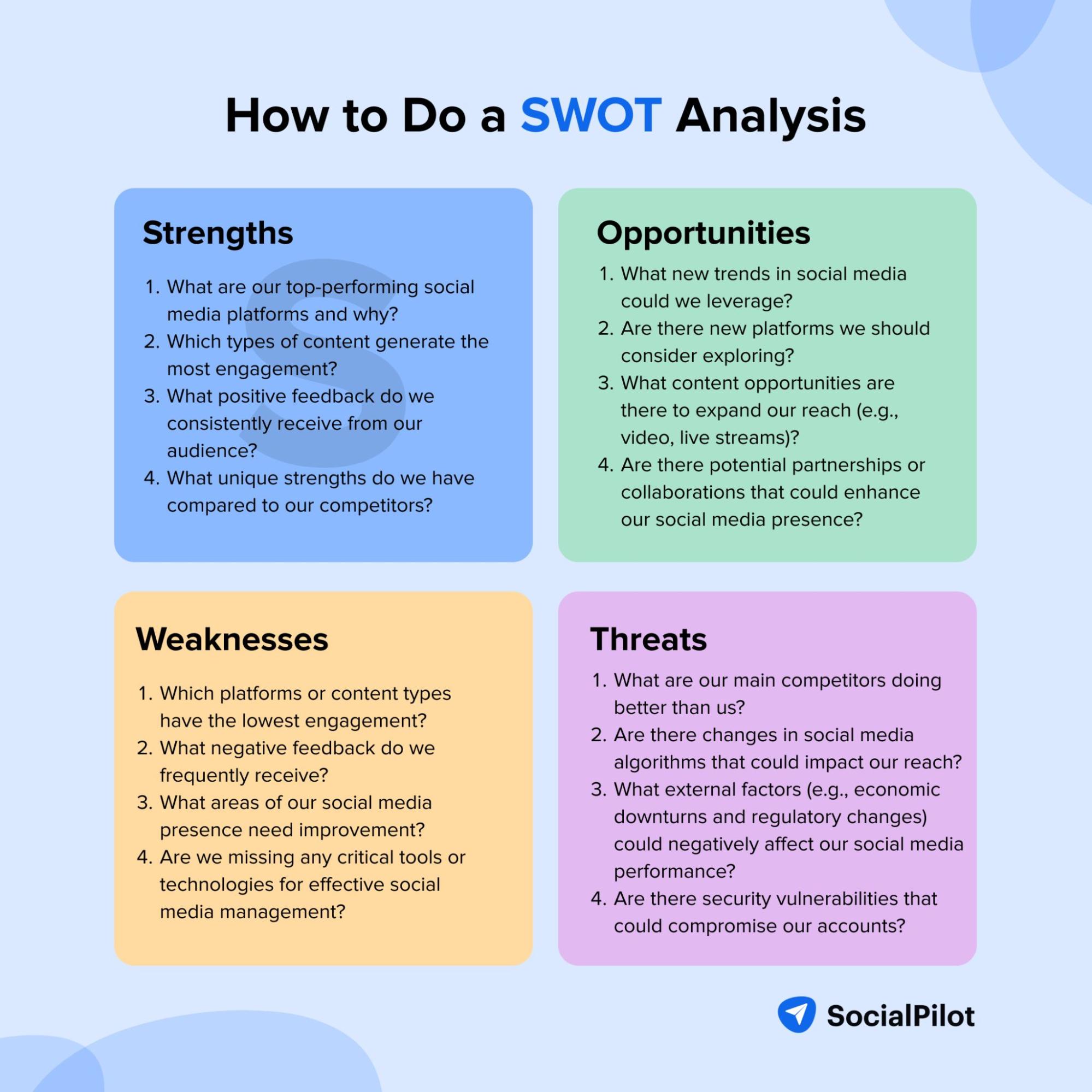
Here is how you can conduct a https://www.socialpilot.co/blog/social-media-swot-analysisSWOT analysis:
- Strengths: Identify the strong points of your social media presence, such as high engagement rates or a well-established brand voice.
- Weaknesses: Recognize the areas that need improvement or are lacking, like inconsistent posting or low follower count.
- Opportunities: Explore potential areas for growth and development, such as new social media platforms or untapped audience segments.
- Threats: Determine external factors that could pose challenges, like competitors or changes in platform algorithms.
Step 8: Prepare Action Items and Update Strategy
Once you’ve collected the data, it’s time to revise your marketing strategy and plan actions to achieve your social media goals. This step is crucial to ensuring that the insights you worked hard to collect are translated into practical actions and enhance your social media presence to achieve your goals.
Here are some questions you can ask yourself to streamline the process of listing action items and updating your strategy:
- Which social media platforms are delivering the best results for us and why?
- What type of content is performing best, and how can we create more of it?
- When is our audience most active, and how can we adjust our posting schedule for maximum engagement?
- What are the most significant strengths identified in our social media audit?
- What weaknesses need immediate attention and improvement?
- What new metrics or KPIs should we track to ensure our updated strategy works?
By addressing these questions, you can ensure your updated strategy is effective and aligns with your business goals.
What about the results?
Reflecting on the results of your actions might take time based on how you execute them and several other factors. Thats why running audits on a regular basis is crucial to optimize your strategy for better results.
Your audits can be as thorough and extensive as you want and include paid advertisements as well.
Wait, you don’t need to scratch your head off; we have created an extensive audit template to do the heavy lifting for you.
Example of a Social Media Audit
Audits are a great way to evaluate your social media presence and performance and identify areas for improvement. However, knowing how to do a social media audit is important to assess all metrics carefully and in a staged manner.
To showcase how you can run a comprehensive audit, let’s illustrate with a practical example. We will conduct a hypothetical social media audit for “EcoTech Solutions,” a company that specializes in eco-friendly technology products.
We’ll conduct an audit focusing on their primary platforms: Facebook, Instagram, and LinkedIn.
Goals and Established KPIs
We have defined our social media goals and KPIs based on our business goals. Here are the following:
- Goal 1: Increase brand awareness
- KPI: Number of impressions and reach
- Goal 2: Boost engagement
- KPI: Engagement rate (likes, comments, shares)
- Goal 3: Drive website traffic
- KPI: Click-through rate (CTR) and referral traffic
List of Social Media Accounts
- Facebook: facebook.com/EcoTechSolutions
- Instagram: instagram.com/EcoTechSolutions
- LinkedIn: linkedin.com/company/EcoTechSolutions
Our Benchmark Scores
Following are some of the benchmarks based on the industry, competitors, and our past data: Facebook:
- Average engagement rate: 4%
- Average reach per post: 1,000
Instagram:
- Average engagement rate: 5%
- Average impressions per post: 1,200
LinkedIn:
- Average engagement rate: 3%
- Average impressions per post: 800
Tools Used: Facebook Insights, Instagram Insights, LinkedIn Analytics, Google Analytics
Performance Data of Social Media Accounts
Here is the performance data of our social media accounts:
Facebook:
- Followers: 10,000
- Average Engagement Rate: 3.5%
- Average Reach per Post: 900
- Top-Performing Content: Videos
Instagram:
- Followers: 8,000
- Average Engagement Rate: 6%
- Average Impressions per Post: 1,500
- Top-Performing Content: User-generated content (UGC)
LinkedIn:
- Followers: 5,000
- Average Engagement Rate: 2.5%
- Average Impressions per Post: 700
Best Performing Content
We reviewed our best-performing posts, and here is what we found out:
- Facebook: Real-life product use case videos received the highest engagement.
- Instagram: User-generated content (UGC) and behind-the-scenes Reels got the most impressions and engagement.
- LinkedIn: LinkedIn posts about industry trends and company achievements had the highest engagement rates.
Our Audience Data
Following is the data of our audience:
Facebook:
- Demographics: 60% male, 40% female; Age: 25-45
- Active Times: 7-9 PM
Instagram:
- Demographics: 55% female, 45% male; Age: 18-35
- Active Times: 6-8 PM
LinkedIn:
- Demographics: 70% male, 30% female; Age: 30-50
- Active Times: 8-10 AM
Doing SWOT Analysis
After going through all the audit analysis, we found out these:
Strengths:
- Very good engagement on Instagram
- High-quality video content on Facebook
- Industry leader on LinkedIn
Weaknesses:
- Less engagement rate on Facebook and LinkedIn
- Inconsistent posting schedule
- Limited use of paid ads
Opportunities:
- Increase the use of videos across all platforms
- Utilize user-generated content more on Instagram
- Use LinkedIn for B2B marketing and partnerships
Threats:
- Competitors have higher social media engagement rates
- Changes in social media algorithms
- Emerging social media platforms
Listing Action Items and Updating Strategy
Action Items
Increase Video Content:
- Responsible: Social Media Manager
- Deadline: Ongoing
- Resources: Video production team, budget for video ads
Leverage User-Generated Content (UGC) on Instagram:
- Responsible: Content Creator
- Deadline: Monthly
- Resources: Collaboration with customers and influencers
Optimize Posting Schedule:
- Responsible: Social Media Analyst
- Deadline: One month
- Resources: Social media scheduling tools
Launch Paid Ad Campaigns:
- Responsible: Digital Marketing Specialist
- Deadline: Next quarter
- Resources: Budget allocation, ad creative team
Enhance LinkedIn Engagement:
- Responsible: Content Strategist
- Deadline: Two months
- Resources: Industry news sources, internal content
Next Steps
- Monitor Progress: Review the performance metrics bi-weekly to ensure the action items are being effectively implemented.
- Update Strategy: Make necessary adjustments based on ongoing performance data and feedback.
- Regular Audits: Schedule regular social media audits every six months to stay updated and continuously improve the strategy.
By following these steps and leveraging the insights gained from this audit, EcoTech Solutions boosted its social media presence and achieved its business objectives effectively.
Additionally, to run a comprehensive audit, you require tools to extract data and compile it to craft strategies. We have compiled a list of some tools you can use for a successful audit.
Social Media Audit Tools
Auditing is a time-consuming and labor-intensive process, but you don’t need to do all the manual work. Here are some of the best tools for social media audit:
SocialPilot
SocialPilot is a social media management tool that provides an extensive look into your social media analytics for an effective auditing process. Whether you’re handling your own social media audit or your clients, this tool helps you track down all the important metrics across channels from one centralized dashboard.
Connect your accounts, and the tool will start pulling data for you. You can see your posts’ likes, comments, shares, and engagement rates. Find out how many new followers you got in a particular period of time, what type of content is rocking for you, and which accounts are the lead performers.
Data charts and visual graphs make it easier to understand and communicate the data. The advanced reports feature also allows you to merge reports from different channels into a single downloadable PDF that you can schedule for sharing with just one click.
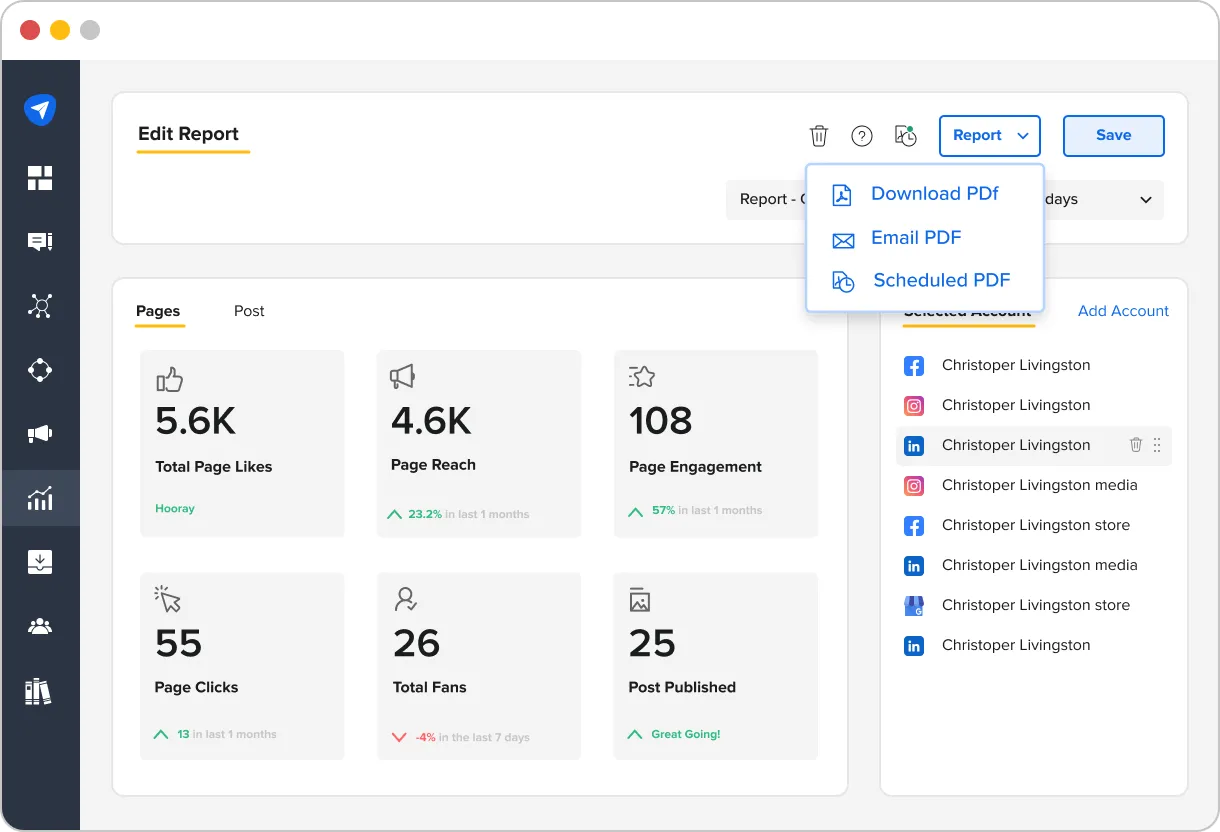
Powerup your social media audits
Google Analytics (GA4)
Google Analytics (GA4) is a great web analytics tool that lets you track user behavior on your website. With this tool, you can track the amount of traffic driven by social media and measure your overall online presence. You can identify how many users signed up for your products/services and which profiles are driving the most social traffic.
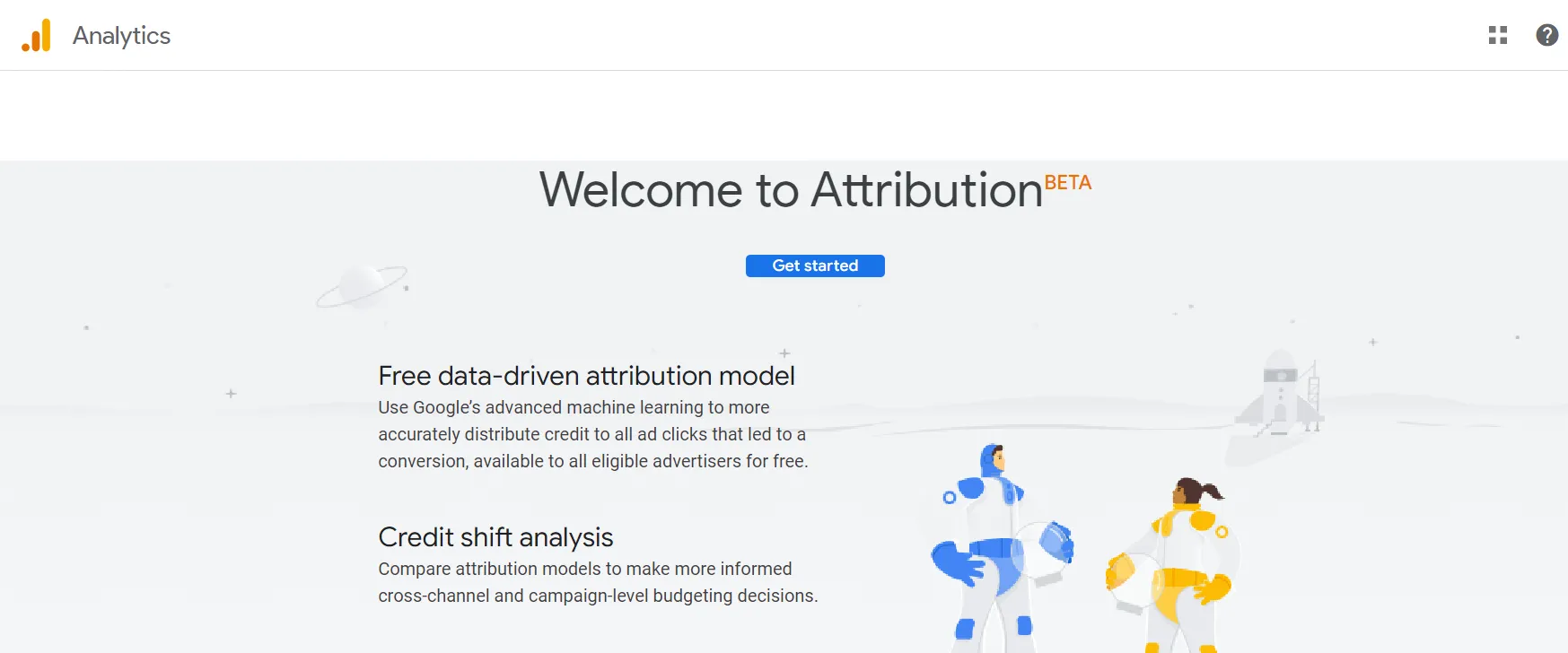
BuzzSumo
BuzzSumo is a powerful content research and analytics tool designed to help businesses, marketers, and content creators discover the most popular content across various platforms. This social media audit tool provides insights into what content is performing well in your niche, allowing you to craft more effective content strategies.
You can generate new content ideas for videos, articles, blog posts, and other types of content. The best part is that you can keep an eye on your competitors by analyzing their posts.
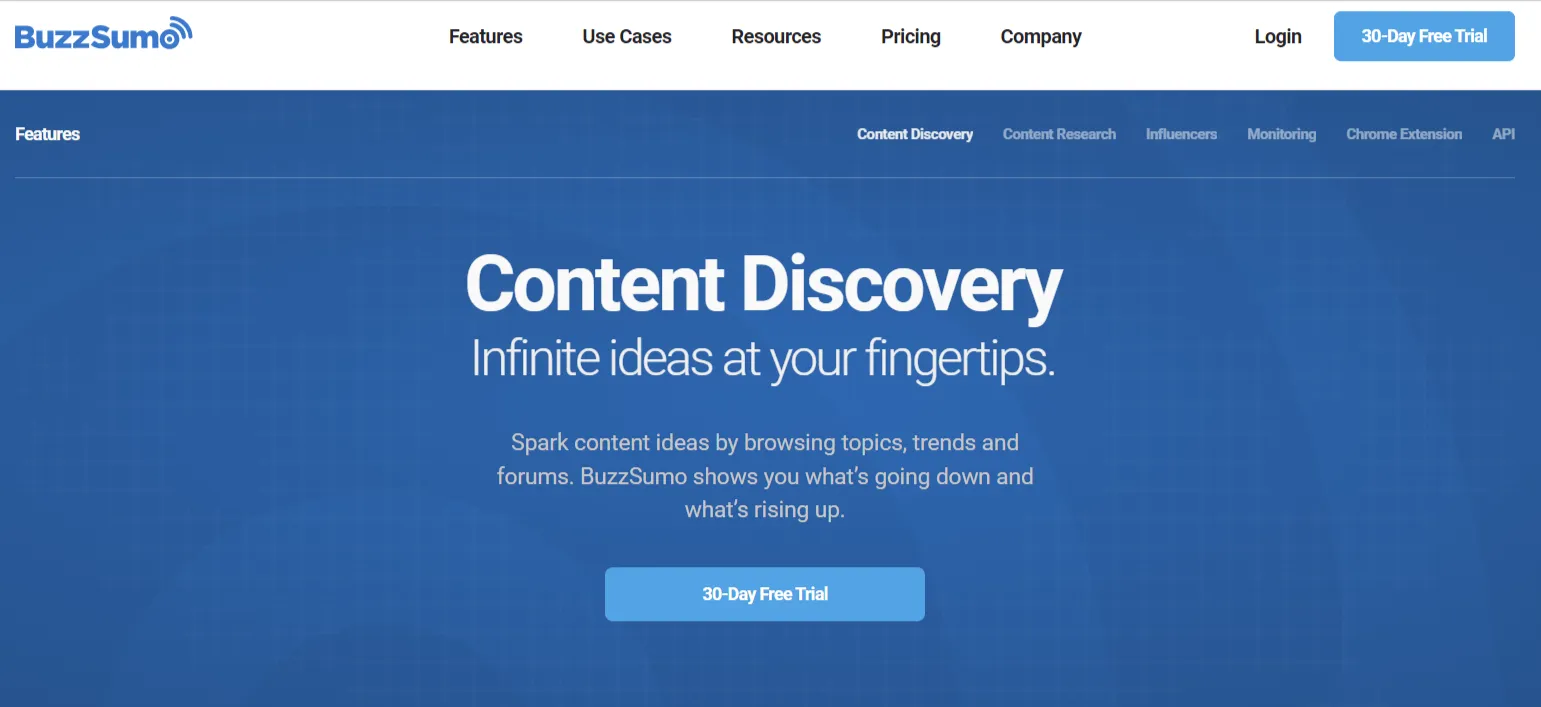
Now that you have some wonderful tools and an amazing template, it’s time to get started with your audit.
Oh, you are done with the audit as well?? Thats great!
Well, we have got a gift for you.
Social Media Audit Checklist for Future Audits
An audit can be as extensive as you want, but you must establish some common grounds to ensure you have completed the basic auditing process. Thats the reason social media managers prefer using a social media audit checklist.
A checklist helps you ensure a detailed and systematic review of your overall social media presence. You can use it to make informed decisions and achieve better results.
We have prepared a detailed checklist for you so you know you are on the right track. Go ahead and download this free resource and fill out this checklist.
This checklist is designed to ensure that all necessary steps are completed during your social media audit. Use it as a guide to track progress, document findings, and make informed decisions to enhance your social media strategy.
Run a Successfully Social Media Audit
Elevating your brand’s social media presence hinges on a strategy informed by rich, actionable data.
A social media audit checklist is your gateway to such invaluable insights, enabling you to refine and optimize your approach across various platforms. The steps provided are your roadmap to conducting a comprehensive audit, ensuring your strategies are always aligned with the dynamic digital landscape.
Remember, regular audits are key to staying ahead. They allow you to seize new opportunities and address any setbacks promptly.
And, when you’re ready to implement your audited strategies, tools like SocialPilot are your allies in seamless growth, offering unmatched scheduling, analytics, and collaboration features.
Dive in with a free trial to experience the transformative impact of SocialPilot on your social media endeavors!
The post 8 Steps to Run a Quick Social Media Audit (+ Free Template) appeared first on SocialPilot.
What's Your Reaction?

































